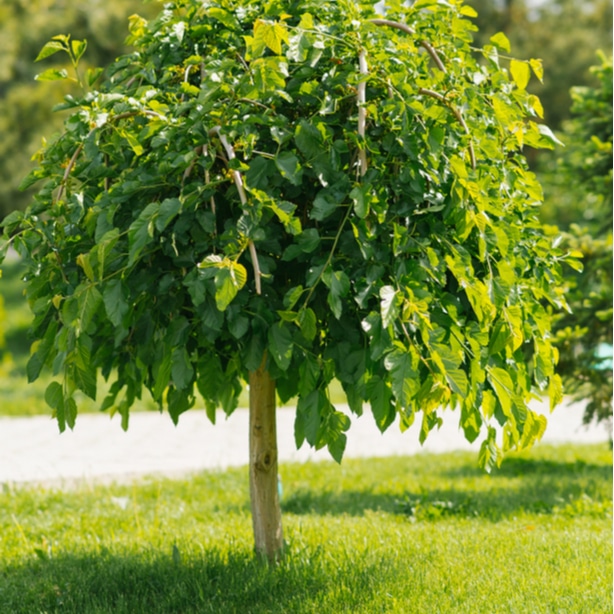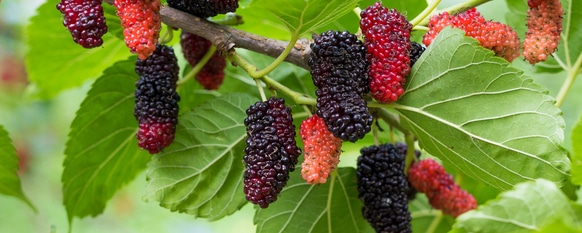This is one deceptive tree. Your parents probably sang you a nursery rhyme when you were younger, in which a “monkey chased the weasel” around it. But the mistake in “Pop Goes the Weasel” is that we refer to it as a bush.
Its fruit perpetrates the second deception. When its fruit ripens, it is commonly mistaken as blackberries or raspberries, depending on the species you encounter. The resemblance is uncanny, but these berries are decidedly longer.
The tree was brought here from Asia with dreams of supporting the silk industry because the leaves of one species are the preferred vegetation of silkworms. Even though the dream of everyone sleeping under silk sheets or wearing silk shirts failed, this tree has flourished in this country. In fact, Alaska and Nevada are the only two states that do not have this tree within their borders.
So let’s give the mulberry tree its just due. This article is the key to helping you learn about the tree and its delicious fruit along with a guide for taking care of it.

General Information
The mulberry tree is a fast-growing deciduous tree found in many temperate regions across the planet. While there are some familiar mulberry varieties, the Morus genus is home to over 200 species of plants.
3 Common species
White, Common, or Silkworm Mulberry (Morus alba)
The white mulberry will grow to a height between 35 and 70 feet. Although some individual specimens have been aged at 250 years, most have a short life-span comparable to that of a human being.
On young trees, the heart-shaped leaves can grow up to 12 inches in length with deep, rounded lobes. On mature specimens, the leaves are between 2 and 6 inches long, unlobed, and serrated on the edges. While species in temperate regions are deciduous in tropical climates, they can become evergreen.
White mulberry fruit grows to be ¼ to ½ of an inch long. In specimens found deep in the wild, the berries will be a deep purple. For cultivated species, the fruits can range from white to pink.
The white mulberry is noted scientifically to have the fastest movement in the plant kingdom. The stamens catapult the pollen out of the catkins at 380 MPH. That’s half the speed of sound.
Black Mulberry
The precise natural range of the black mulberry is unknown because it was so widely cultivated for its fruit and other uses. This species can grow to be 40 feet tall and have a canopy that measures 50 feet across.
Black mulberry leaves are between 4 and 8 inches long and 2 to 4 inches wide. The species can be distinguished by its rough surface and very short, stiff hairs.
The delicious, dark black mulberry fruit is not quite black (but it’s close) and can grow to lengths between 1 and 1 ½ inches.
Red Mulberry
Red mulberries are the only species native to the United States. They can live to be 125 years old. They can grow as tall as 70 feet but average somewhere between 35 and 50 feet tall.
The alternate leaves of the red mulberry grow to be between 3 and 7 inches long and between 3 and 4 ½ inches wide. The upper surface of the leaf is textured like fine sandpaper and the underside is covered in short, soft hairs.
Initially a light green color, the fruit of the red mulberry will ripen to be red or dark purple. The fruit grow to be between ¾ and 1 ¼ inch long.
In addition to their fruit, mulberries are prized shade trees. Their wood can be used to smoke meats and provide a mild sweet flavor. Their leaves also have an array of medicinal, culinary, and industrial applications.

Care Guide
The red and white mulberries are hardier than the black mulberry. In certain circumstances, the black variety may require slightly different conditions for optimal growth.
Sunlight Requirements
All three species require full-sun and need to be spaced at least 15 feet apart to account for their expansive and wild-growing root systems. While in most instances, the white and red varieties require 4 hours of direct, unfiltered sunlight, there are certain growing conditions where they thrive in partial shade.
Watering
These trees are somewhat drought tolerant. For newly planted trees, water regularly to promote the growth of a healthy root system. Once established, they should receive their water requirements from the environment. During dry periods, you must ensure they are receiving at least 1 inch of water deep into the soil every week. If you allow the roots to dry up, the fruit will drop to the earth before they have ripened.
Ensure that you don’t over water. The roots of these trees are susceptible to rot if confined in saturated conditions.

Soil Conditions
Mulberry trees do well in a wide variety of soils that can range from sandy to loamy to clay and even to rocky. In that regard, they are not picky.
They can grow in acidic or alkaline soils, but they prefer the pH level to fall between 5.0 and 5.7. These trees are very salt-tolerant and, as such, do well in coastal conditions.
Mulberries are partial to well-drained soils that are slightly moist but not soggy.
Fertilizing
Mulberry trees should not be fertilized during their first year of growth. Depending on what your soil test tells you, it might be possible to wait until after the second year of growth to fertilize them.
Once they are established, use a balanced, slow-release fertilizer with an NPK ratio of 10-10-10 in late winter or early spring, just before new growth begins. Use 1 pound of fertilizer for every inch of trunk diameter.
If your mature tree is not showing any signs of recent growth but is otherwise healthy without signs of stress, you may only need to apply nitrogen to supplement its nutrient needs.

Pruning
These trees require minimal maintenance. How you prune your mulberry tree depends on the goals you have for your landscape.
If your goal is to create a cool, shady spot to sit under that also provides an environment for wildlife, then only cut back the dead, diseased, and broken limbs. If this is your goal, you’ll only have to break out the trimming equipment every 2 or 3 years.
If your goal is fruit production, then you must trim annually. These fruit trees bloom and regrow their bounty on the previous year’s growth. So extensive trimming will cause decreased fruit production. Cut limbs to control the overall size and keep the fruit within reach.
Regardless of your goal, pruning is best done after the tree has gone dormant. You’ll have a better view of what you’re cutting back.
Growing Tips
Here are some tips for growing mulberry trees.
Planting
Recommended planting is in the early fall so the fast-growing roots can establish themselves before the growing season. Planting in spring is perfectly fine too, just make sure that you’re watering them enough in the beginning.
These trees grow well from seed and can be propagated as well. However, it’s easiest to purchase a young tree from your local garden center or forestry association because they are easily transplanted.
Take care of the roots in the winter months and keep them from freezing. Placing a layer of mulch that covers a radius of 3 feet out from the base of the tree will provide that protection.

Where Not to Plant Them
Whenever planting new varieties, ensure that you’re doing so far enough away from your driveways and sidewalks that the mulberry fruits do not fall onto their surfaces. The deep, rich colors will leave deep, rich stains on your driveway, your cars, and your clothes. So be mindful of how large they will grow before you put them in the ground. There is a fruitless variety of mulberry tree if this is unavoidable.
Where to Plant Them
If you’re having issues with erosion, these trees’ wild-growing roots are perfectly suited to helping fix that issue.
Some cultivars are extremely resistant to strong winds. If you have an area of your home that seems to funnel the wind through it, planting this tree in that location can be a beautiful windbreak.
Harvesting Mulberries
When the fruit on your mulberry tree turns a deep purple shade that is almost black, it is ready to be harvested. This usually occurs in late spring to early summer.
Ripe fruit should pull away from its branch with ease. Take care not to jerk or pull forcefully as the branch’s rebound can cause other ripened berries to fall to the ground. This will prevent damage to the berries.
If you find this an impossibility (which is a very common thing), place a blanket or tarp underneath the canopy and gently shake the tree. Simply gather the berries and enjoy the spoils. Often, this is the preferred method because it’s easier and less time-consuming.
Unwashed mulberries will keep in a sealed container in the fridge for several days. You can eat them raw, use them to make jellies or jams, or baked goods of all kinds. You can choose to freeze them, but they don’t dry well, so you’ll run into some problems when they thaw.

Pests and Problems
Fortunately, you’ll encounter very few problems with insects in your tree. You may find mites or mealybugs, but you can get rid of them with a powerful stream of water from your garden hose.
If you live in the South, there is a possibility of an issue with boring insects. However, these are considered secondary pests and are indicative of a bigger problem with the tree.
You’ll be visited by birds and other woodland creatures whenever the mulberry fruit appears. There is not a lot you can do about this. Not to worry though, the mulberry produces a bountiful harvest that should bear plenty of fruit to go around.
Even with the best of care, a mulberry can contract a fungal sickness called popcorn disease. This disease lives up to its name as it causes the fruit to swell and gives it a popcorn-like appearance. Infected berries will fall from the tree and should be removed as soon as possible, so the disease doesn’t hang around to hurt next year’s harvest. You can spray the entire tree with a fungicide containing copper and hopefully save the fruit that hasn’t been infected.


We were blessed to realize a full grown mulberry tree in my grand daughters chicken yard. It has since been a contest for the berries. Wanted to transplant a small one at our house. Imagine my surprise when cleaning out an area behind my own house, I came acrost a good sized white mulberry tree.
Now working to free up the competition for space and enjoy a crop next year. We enjoy pies from Mulberrys.
Pies made from their fruit are delicious! Sometimes I wonder why Mulberries aren’t more popular than they are!